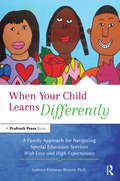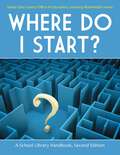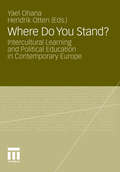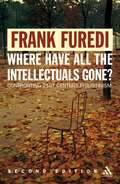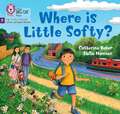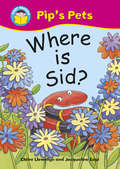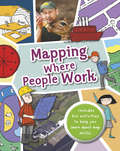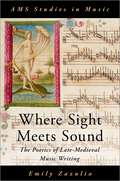- Table View
- List View
When Your Child Learns Differently: A Family Approach for Navigating Special Education Services With Love and High Expectations
by Kathryn Fishman-WeaverAdvocating for a child who learns differently can sometimes feel like an isolating and daunting task. This book reminds families that they are not alone. When Your Child Learns Differently is a compassionate guide that:
Where Are they Now?: A Tenth-anniversary Retrospective:a Special Issue of the journal of Education for Students Placed at Risk
by Samuel C. StringfieldFirst Published in 2005. Routledge is an imprint of Taylor & Francis, an informa company.
Where Are they Now?: A Tenth-anniversary Retrospective:a Special Issue of the journal of Education for Students Placed at Risk
by Samuel C. StringfieldFirst Published in 2005. Routledge is an imprint of Taylor & Francis, an informa company.
Where Did We Go Wrong?: Industrial Performance, Education and the Economy in Victorian Britain (Routledge Library Editions: Education 1800-1926)
by Gordon Roderick Michael StephensThis series of edited papers, first published in 1981, examines Britain’s industrial and commercial performance in the 19th and 20th centuries against the background of the development of state education. The performance of certain key 19th century manufacturing industries are analysed and the reasons for their relative decline in the face of foreign competition is assessed. This title will be of interest to students of history and education.
Where Did We Go Wrong?: Industrial Performance, Education and the Economy in Victorian Britain (Routledge Library Editions: Education 1800-1926)
by Gordon Roderick Michael StephensThis series of edited papers, first published in 1981, examines Britain’s industrial and commercial performance in the 19th and 20th centuries against the background of the development of state education. The performance of certain key 19th century manufacturing industries are analysed and the reasons for their relative decline in the face of foreign competition is assessed. This title will be of interest to students of history and education.
Where Do I Start?: A School Library Handbook
by Santa Clara County Office of EducationIf you're new to running a library or looking for a refresher, this book can serve as your first reference source for school library operation, providing overview information on a wealth of topics, lists of resources for more in-depth information, and coverage of current topics such as Web 2.0, fundraising, digital booktalks, and cybersafety.With the extreme budget cuts most school libraries are facing, professional development resources for library support staff that improve library management efficiency are in great demand. This popular handbook provides an overview of many topics related to school libraries, collecting a vast amount of information together in one volume with an extensive index and selected additional resources.Written in an accessible style, it provides a quick reference and overview information for the operation of school libraries that both experienced and new library staff will find useful. Designed to be read both cover-to-cover and utilized as a ready reference, the second edition of Where Do I Start?: A School Library Handbook has updated subject material that includes coverage of Web 2.0 applications, library web pages, reading books to students, digital storytelling, future trends in library automation, and more.
Where Do I Start?: A School Library Handbook
by Santa Clara County Office of EducationIf you're new to running a library or looking for a refresher, this book can serve as your first reference source for school library operation, providing overview information on a wealth of topics, lists of resources for more in-depth information, and coverage of current topics such as Web 2.0, fundraising, digital booktalks, and cybersafety.With the extreme budget cuts most school libraries are facing, professional development resources for library support staff that improve library management efficiency are in great demand. This popular handbook provides an overview of many topics related to school libraries, collecting a vast amount of information together in one volume with an extensive index and selected additional resources.Written in an accessible style, it provides a quick reference and overview information for the operation of school libraries that both experienced and new library staff will find useful. Designed to be read both cover-to-cover and utilized as a ready reference, the second edition of Where Do I Start?: A School Library Handbook has updated subject material that includes coverage of Web 2.0 applications, library web pages, reading books to students, digital storytelling, future trends in library automation, and more.
Where Do You Stand?: Intercultural Learning and Political Education in Contemporary Europe
by Yael Ohana Hendrik OttenThis publication takes up the many and often controversial debates about the nature, content, methods and political significance of intercultural learning in and for the European youth field. Its starting point is the current depoliticisation of intercultural learning in this field, and especially in the programmes of the European Commission and the Directorate of Youth and Sport of the Council of Europe over the last several years. At the same time, the elevation of “intercultural dialogue” to panacea for all societal problems, from civil war to educational failure, is putting the mobilisational value of intercultural learning to the test.
Where Have All the Intellectuals Gone?: Confronting 21st Century Philistinism
by Frank FurediIn this urgent and passionate book, Frank Furedi explains the essential contribution of intellectuals both to culture and to democracy - and why we need to recreate a public sphere in which intellectuals and the general public can talk to each other again.
Where Have All the Intellectuals Gone?: Confronting 21st Century Philistinism
by Frank FurediIn this urgent and passionate book, Frank Furedi explains the essential contribution of intellectuals both to culture and to democracy - and why we need to recreate a public sphere in which intellectuals and the general public can talk to each other again.
Where Is Sid? (Start Reading: Pip's Pets)
by Claire LlewellynThe 'Pip's Pets' series uses simple stories to help young readers develop basic literacy skills, supplementing learning at both Foundation Stage and Key Stage 1.
Where Is the Teacher?: The 12 Shifts for Student-Centered Environments
by Kyle WagnerKids today can learn more from a five-minute YouTube video or AI chatbot than they can from a full day of lectures. So what then is our role as classroom teachers? In this groundbreaking book, seasoned educator Kyle Wagner explains the new role of the teacher in the 4th industrial revolution. You will learn how to shift from being a deliverer of content, to a thoughtful designer and facilitator of student-centered learning experiences who gently guides from behind the scenes. Kyle, a veteran co-learning experience designer, former classroom teacher, and school leader, unpacks each of the 12 shifts required to build these student-centered environments. Chapters cover how to shift from a content-based to inquiry-based approach; develop relevant, interdisciplinary skills; cultivate meaningful student reflection; curate beautiful, real-world work; facilitate student-led discussion; and more. Through stories from real student-centered classrooms around each shift, and anecdotes from the author’s experience teaching and leading micro-academies, you will come away ready to unleash student creativity, build thoughtful inquirers, and develop self-directed learners within your own context.
Where Is the Teacher?: The 12 Shifts for Student-Centered Environments
by Kyle WagnerKids today can learn more from a five-minute YouTube video or AI chatbot than they can from a full day of lectures. So what then is our role as classroom teachers? In this groundbreaking book, seasoned educator Kyle Wagner explains the new role of the teacher in the 4th industrial revolution. You will learn how to shift from being a deliverer of content, to a thoughtful designer and facilitator of student-centered learning experiences who gently guides from behind the scenes. Kyle, a veteran co-learning experience designer, former classroom teacher, and school leader, unpacks each of the 12 shifts required to build these student-centered environments. Chapters cover how to shift from a content-based to inquiry-based approach; develop relevant, interdisciplinary skills; cultivate meaningful student reflection; curate beautiful, real-world work; facilitate student-led discussion; and more. Through stories from real student-centered classrooms around each shift, and anecdotes from the author’s experience teaching and leading micro-academies, you will come away ready to unleash student creativity, build thoughtful inquirers, and develop self-directed learners within your own context.
Where is the Wise Man?: Graeco-Roman Education as a Background to the Divisions in 1 Corinthians 1-4 (The Library of New Testament Studies #536)
by Adam G. WhiteThe divisions in the Corinthian church are catalogued by Paul in 1 Corinthians 1:12: "Each of you says, 'I follow Paul,' or 'I follow Apollos,' or 'I follow Cephas,' or 'I follow Christ.'” White shows how these splits are found in the milieu of 1st-century Graeco-Roman education. By consulting relevant literary and epigraphic evidence, White develops a picture of ancient education throughout the Empire generally, and in Roman Corinth specifically. This serves as a backdrop to the situation in the Christian community, wherein some of the elite, educated members preferred Apollos to Paul as a teacher since Apollos more closely resembled other teachers of higher studies. White takes a new and different direction to other studies in the field, arguing that it is against the values inculcated through “higher education” in general that the teachers are being compared. By starting with this broader category, one that much better reflects the very eclectic nature of Graeco-Roman education, a sustained reading of 1 Corinthians 1–4 is made possible.
Where is the Wise Man?: Graeco-Roman Education as a Background to the Divisions in 1 Corinthians 1-4 (The Library of New Testament Studies)
by Dr Adam G. WhiteThe divisions in the Corinthian church are catalogued by Paul in 1 Corinthians 1:12: "Each of you says, 'I follow Paul,' or 'I follow Apollos,' or 'I follow Cephas,' or 'I follow Christ.'” White shows how these splits are found in the milieu of 1st-century Graeco-Roman education. By consulting relevant literary and epigraphic evidence, White develops a picture of ancient education throughout the Empire generally, and in Roman Corinth specifically. This serves as a backdrop to the situation in the Christian community, wherein some of the elite, educated members preferred Apollos to Paul as a teacher since Apollos more closely resembled other teachers of higher studies. White takes a new and different direction to other studies in the field, arguing that it is against the values inculcated through "higher education” in general that the teachers are being compared. By starting with this broader category, one that much better reflects the very eclectic nature of Graeco-Roman education, a sustained reading of 1 Corinthians 1–4 is made possible.
Where on Earth?: Band 11/Lime (Collins Big Cat)
by Scoular Anderson Cliff Moon Collins Big CatWhere on Earth describes the journeys of significant explorers, revealing the lands they discovered and what they found there. Grid maps and grid references offer children an opportunity to find out for themselves where each explorer sailed.
Where People Work: Where People Work (Mapping #3)
by Jen GreenFull of hands-on activities to help you learn all about map skills whilst also learning about the features of a where people work. This book will show you what a bird's eye map is by looking at aerial photos; how landmarks can be shown as symbols; how to measure scale and distance; what map plans are; how compass points show you how to find directions; how to follow pathways and roads; how to use grid references; looking at landuse ; and looking at transport maps.Illustrations by Sarah Horne in an amusing and lively style are combined with photographs to really capture a child's attention helping them to learn these important map skills.
Where Shall Wisdom be Found?: Calvin's Exegesis of Job from Medieval and Modern Perspectives
by Susan E. SchreinerThrough countless retellings, from the Talmud to Archibald MacLeish and since, the story of Job has become a fixture in the cultural imagination of the West. In this study, Susan E. Schreiner analyzes interpretations of the Book of Job by Gregory the Great, Maimonides, Thomas Aquinas, and particularly John Calvin. Reading Calvin's interpretation of Job against the background of his most important medieval predecessors, Schreiner shows how central Job is to Calvin's struggles with issues of creation, the problem of evil, the meaning of history, and the doctrine of providence. For Calvin and his predecessors, Schreiner argues, the concept of intellectual perception is the key to an understanding of Job. The texts she examines constantly raise questions about the human capacity for knowledge: What can the sufferer who stands within history perceive about the self, God, and reality? Can humans truly perceive the workings of providence in their personal lives or in the tumult of history? Are evil and injustice a reality that we must confront before finding wisdom? In her final chapter, Schreiner turns to the wide array of twentieth-century interpretations of Job, including modern biblical commentaries, the work of Carl Jung, and literary transfigurations by Wells, MacLeish, Wiesel, and Kafka. The result is a compelling demonstration of how the history of exegesis can yield vital insights for contemporary culture.
Where Sight Meets Sound: The Poetics of Late-Medieval Music Writing (AMS Studies in Music)
by Emily ZazuliaThe main function of western musical notation is incidental: it prescribes and records sound. But during the fourteenth and fifteenth centuries, notation began to take on an aesthetic life all its own. In the early fifteenth century, a musician might be asked to sing a line slower, faster, or starting on a different pitch than what is written. By the end of the century composers had begun tasking singers with solving elaborate puzzles to produce sounds whose relationship to the written notes is anything but obvious. These instructions, which appear by turns unnecessary and confounding, challenge traditional conceptions of music writing that understand notation as an incidental consequence of the desire to record sound. This book explores innovations in late-medieval music writing as well as how modern scholarship on notation has informedsometimes erroneouslyideas about the premodern era. Drawing on both musical and music-theoretical evidence, this book reframes our understanding of late-medieval musical notation as a system that was innovative, cutting-edge, and dynamicone that could be used to generate music, not just preserve it.
Where Sight Meets Sound: The Poetics of Late-Medieval Music Writing (AMS Studies in Music)
by Emily ZazuliaThe main function of western musical notation is incidental: it prescribes and records sound. But during the fourteenth and fifteenth centuries, notation began to take on an aesthetic life all its own. In the early fifteenth century, a musician might be asked to sing a line slower, faster, or starting on a different pitch than what is written. By the end of the century composers had begun tasking singers with solving elaborate puzzles to produce sounds whose relationship to the written notes is anything but obvious. These instructions, which appear by turns unnecessary and confounding, challenge traditional conceptions of music writing that understand notation as an incidental consequence of the desire to record sound. This book explores innovations in late-medieval music writing as well as how modern scholarship on notation has informedsometimes erroneouslyideas about the premodern era. Drawing on both musical and music-theoretical evidence, this book reframes our understanding of late-medieval musical notation as a system that was innovative, cutting-edge, and dynamicone that could be used to generate music, not just preserve it.
Where Tenure Does Not Reign: Colleges with Contract Systems
by Richard Chait Cathy A. TrowerPresents the experiences of campuses without tenure and campuses where faculty may choose tenure or contracts. Issues covered include academic freedom, faculty recruitment, selectivity, turnover, and reward structures. Answers the question, "What lessons can be learned from campuses with contract systems?"
Where Tenure Does Not Reign: Colleges with Contract Systems
by Richard Chait Cathy A. TrowerPresents the experiences of campuses without tenure and campuses where faculty may choose tenure or contracts. Issues covered include academic freedom, faculty recruitment, selectivity, turnover, and reward structures. Answers the question, "What lessons can be learned from campuses with contract systems?"
Where Texts and Children Meet
by Eve Bearne Victor WatsonIt is impossible to reflect upon children's books without considering the children who read them. Where Texts and Children Meet explores the ways in which children make meaning of the various texts they meet both in and out of school.Eve Bearne and Victor Watson have brought together chapters on all the major issues and topics in children's literacy including: * the meaning and relevance of terms such as literature and classic texts* an analysis of new genres including picture books and CD-ROMs* moral dilemmas and cultural concerns in children's texts* working with quality texts that children will also adore. Where Texts and Children Meet shows how the world of children's books is changing and how teachers can build imaginative learning experiences for their pupils from a whole range of published materials.
Where Texts and Children Meet
by Eve Bearne Victor WatsonIt is impossible to reflect upon children's books without considering the children who read them. Where Texts and Children Meet explores the ways in which children make meaning of the various texts they meet both in and out of school.Eve Bearne and Victor Watson have brought together chapters on all the major issues and topics in children's literacy including: * the meaning and relevance of terms such as literature and classic texts* an analysis of new genres including picture books and CD-ROMs* moral dilemmas and cultural concerns in children's texts* working with quality texts that children will also adore. Where Texts and Children Meet shows how the world of children's books is changing and how teachers can build imaginative learning experiences for their pupils from a whole range of published materials.
